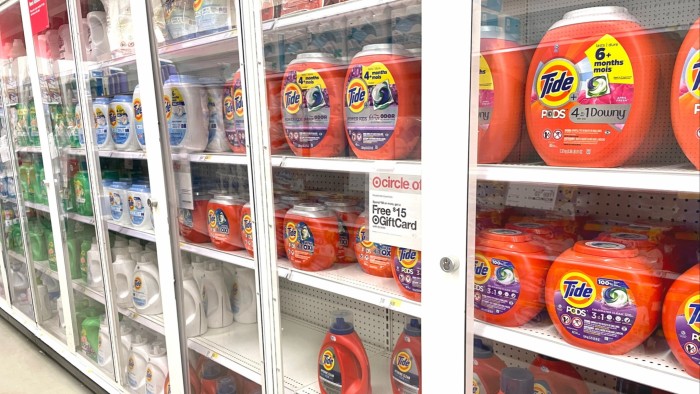Body cameras on security guards greet shoppers at TJ Maxx. Customers in Walmart’s beer aisles can watch themselves on overhead video monitors. Drugstore patrons find toothpaste locked behind Plexiglas.
All have become part of the US retail landscape as the costs of shoplifting and more aggressive types of theft have climbed to tens of billions of dollars a year. But even as retailers adopt high-tech eavesdropping techniques in an attempt to win the war on shoplifting, new evidence indicates they are losing.
Theft has led to a complex set of problems for US retailers: vanishing products cut into sales and add overhead costs for insurance and additional security measures. A 2023 industry survey found external theft accounted for 36 per cent, or $40bn, of so-called shrink, a measure of inventory losses.
Frustration over locked-up merchandise is also causing shoppers to flee stores: nearly a fifth of store customers encountering such goods opt to shop online, according to Numerator, a market research firm.
The most-stolen items are often those that are easy to pocket or lucrative to fence: cosmetics and deodorant at drugstores, or power tools at home improvement chains.
Target earlier this year said shrink costs increased more than $500mn in 2023 compared with 2022.
A report from the Council on Criminal Justice released on Wednesday indicated shoplifting is on track to rise from 2023 to 2024 in a 23-city sample. The three biggest cities of New York, Los Angeles and Chicago all have more shoplifting than before the Covid-19 pandemic.
Some retailers said efforts to curb theft are showing results. Richard McPhail, Home Depot’s chief financial officer, last week said: “This is a problem for all of retail. It’s hard to quantify. What we can tell you is that our investments are paying off.”
Walmart, the biggest US retailer, on Tuesday said its outlook for shrink had become “a little bit better in the US” than anticipated at the start of the year.
Retail theft has become a prominent social issue as shoppers confront locked store shelves and videos of brazen stealing circulate on social media. Voters in California this month restored felony status to the act of repeat shoplifting, after a decade classifying it as a misdemeanour. As a candidate, president-elect Donald Trump said store thieves should be shot.
Retailers have responded with new ways to deter shoplifting. Many depend on electronic surveillance.
Security cameras are now equipped with computer vision, which can pick up on cues such as a suspicious gait or shelf sweeps, according to Coresight, a research company.
Cameras in the parking lots of Home Depot stores are now able to scan not only licence plates but the colours, scrapes and dents on individual vehicles. The technology can tip off the company to the arrival of a car tied to suspected thefts at other stores.
Scott Glenn, Home Depot’s vice-president of asset protection, said: “We’ve done low-tech things, like securing product behind cages. We’ve added locking carts to our stores, so that people can’t just easily cart a lot of merchandise out of our store. We’ve added camera packages, public view monitors, off-duty policy officers and guards in our stores.”
“And then there’s a whole array of behind the scenes technologies that I’m not going to get too much into because they’re a little bit secret sauce,” he added.
As retailers have installed self-checkout kiosks to save money on cashiers, some have also suffered a rise in stolen merchandise. The discount chain Dollar General is removing self-checkout lanes from the majority of its 20,000 stores to combat shrink.
But the retail industry has gotten wise to self-checkout tricks such as transferring the bar code sticker from a cheap item to an expensive one, and have now installed more sophisticated scanners at self-checkout.
David Wilkinson, chief executive of NCR Voyix, which supplies self-checkout and point-of-sale technologies to retailers including Walmart and Target, said: “I can tell the difference between a package of Kool-Aid and a T-bone steak even if you’ve taken the bar code off of the Kool-Aid pack and tried to scan a steak over that.”
Checkout cameras also aim at customers. “We find there’s a psychological impact of knowing that you’re being watched,” Wilkinson said in an interview earlier this year.
Some retailers have embraced facial recognition technology to identify visitors suspected of past theft or other crimes. FaceFirst, a Texas-based vendor, said its algorithm “can find every recent instance of that person entering all your locations. The result? A human investigation with advanced [artificial intelligence] confirmation that calculates past losses, plus date/time stamped evidence packaged for law enforcement agencies and prosecutors.”
The technology has drawn resistance. A third of US consumers surveyed by Coresight said they would shop less often or avoid shopping in a store whose cameras were equipped with facial-recognition software. A federal regulator last December banned Rite Aid from using facial recognition for surveillance purposes for five years, after charging the drugstore chain of falsely accusing customers of wrongdoing based on erroneous matches.
“Facial recognition is a very powerful surveillance technology,” said Jeramie Scott, senior counsel at the Electronic Privacy Information Center. “And when retailers deploy this with their customers and employees, you lose your anonymity and control over your identity. You can now be connected not only to the store you’re going into but the things you look at, who you’re with . . . Every action in a store becomes a potential data point for scrutiny and analysis.”
Ernesto Lopez, a senior research specialist at CCJ, said it was not surprising that some retailers would be pointing to less shrink even if reported shoplifting rates are rising.
With new technologies deployed to stop shoplifting, “it could be an increase in detection”, he said.
Read the full article here

